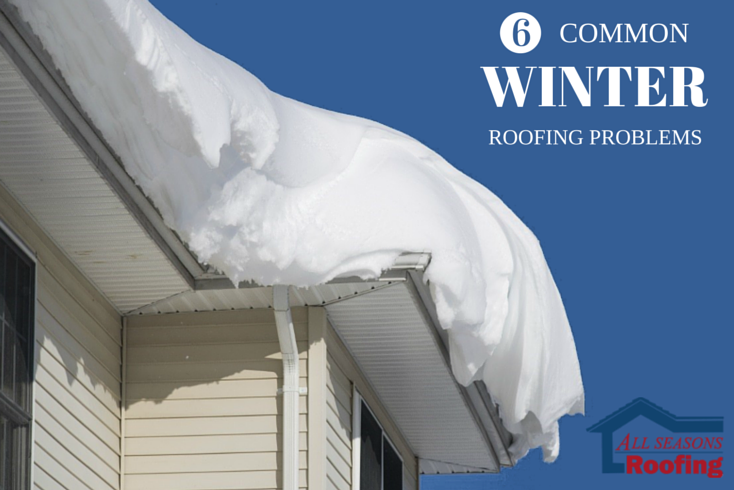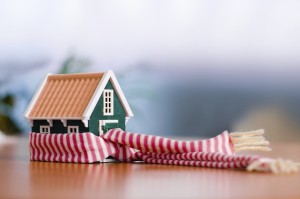
Common Winter Roofing Problems You May Experience in Utah
By now, many Utah residents are no doubt worrying that what happened in Buffalo, New York recently could happen to them this winter. Hundreds of Buffalo residents are currently suffering from roofs that are collapsing under the crushing weight of heavy snow, in addition to leaking roofs and extensive interior damage to their homes.
Would your roof hold up under several feet of snow in its present condition? When was the last time you ventured onto your home’s rooftop to see exactly what was going up there?
Don’t wait until 10 feet of snow has buried the entire state of Utah–including your house. Remain aware of how snow, ice, sleet and frigid winds can compromise your roof and reduce its ability to withstand severe winter weather.
Watch Out for These 6 Sneaky Roof Problems

Winter Roofing Problem – Ice Dams
As inch after inch of snow accumulates on your roof and air temperature fluctuates from below freezing to above freezing, the destructive cycle of refreezing and melting is rapidly deteriorating your roof. Compounding this cycle is the interior temperature of your attic, since overly warm attics increase the amount of melting snow runoff on your roof’s surface. Normally, this excess water would flow off the roof if temperatures remained above freezing. Unfortunately, Utah winters are viciously cold. Instant refreezing of this melt off and growing blocked of ice that inhibit melting snow runoff will inevitably result in the formation of ice dams that degrade shingles and force leakage of excess water into your home.
Winter Roofing Problem – Condensation
Moisture developing at roof ceiling areas that is trapped by radiant barriers or foil insulation can destroy an entire roof. Most roofs harbor vapor retardants which cover purlin beams under the roof structure. Daytime heating of buildings is conducive to roofing material that readily absorbs the sun’s ultraviolet energy. Consequently, heat builds up in the air pockets between the roof and insulation. Evaporation increases and more moisture is drawn into the air cavity. Due to the barrier capabilities of insulation, roof cells cannot vent to allow moisture to dry out. Result–extensive damage to your attic’s structural elements (trusses, rafters, etc.), formation of ice dams and leaking into the walls of your home.
Winter Roofing Problem – Snow and Ice Buildup
Those impressive icicles you see hanging from the eaves of your home may mean you have clogged or broken gutters that are preventing excess melt from running off your roof. What’s happening to Buffalo, NY residents could happen to you if the reason behind snow and ice buildup isn’t found and fixed–a collapsing roof and thousands of dollars in repairs.
Winter Roofing Problem – Roof/Flashing Leaks
Improperly “flashed” windows, doors and roofs are common discrepancies found during professional home and roof inspections. Flashing refers to thin pieces of weather resistant barriers designed to block water from entering a structure. Nearly all wall and roof leaks can be attributed to bad installation of flashing but since these types of leaks happen gradually, most Utah homeowners don’t realize the extent of water damage occurring to their home–until it is too late.
Winter Roofing Problem – Shingle Damage
Although shingles are made with tough, weather-resistant materials, they are not impervious to damage caused by the sun’s potent UV rays, rodent and insect pests searching for a place to nest and the wrath of Mother Nature, who seems to take delight in destroying shingles with pounding thunderstorms, gale-force windstorms and hailstorms. Curling edges, surface cracking, blistering and staining signifies the end of life for a shingled roof–and imminent leaking inside your home.
Winter Roofing Problem – Poorly Ventilated Attic
Attics with little to no ventilation directly contribute to condensation, mold and mildew growth, rust, sagging decking (caused by dissolution of adhesives holding attic decking together), ice dams, frost and overall deterioration of the roofing system. In addition, when heat and condensation builds in crawlspaces and attics, A/C units must work harder to cool your home during the summer. This means significant increases in your energy bills and reduced operating life of overheated air conditioners.
What Can You Do to Avoid Extensive Shingle Damage, Leaking or Collapsing Roofs in the Dead of a Utah Winter?
The benefits of having a complete roof inspection cannot be emphasized enough. Avoid costly repairs, weeks spent living in a cramped hotel room and other stressful issues by visiting our website at http://roofingallseason.com. We not only offer financing options to minimize budget problems but also offer free roofing estimates. Call us today at (801) 557-4416.
Latest posts by Jake Hardy (see all)
- Roof Snow Removal 101 – Preventing Collapse - December 16, 2014
- Common Winter Roofing Problems You May Experience in Utah - November 24, 2014
- Seven Things You Must Know Before Choosing a Roofing Company in Utah - October 19, 2014






Leave a Reply
You must be logged in to post a comment.